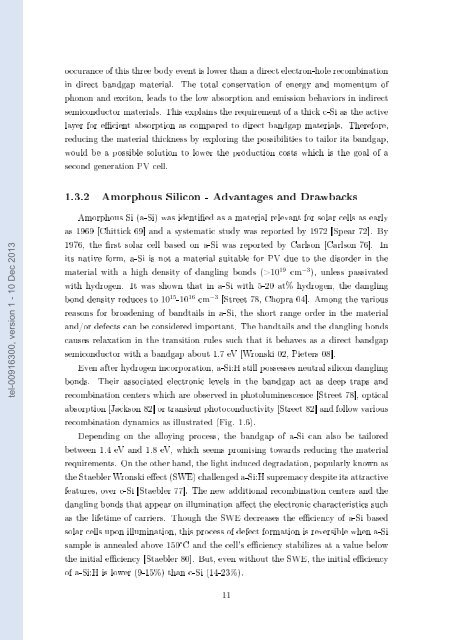Films minces à base de Si nanostructuré pour des cellules ...
Films minces à base de Si nanostructuré pour des cellules ...
Films minces à base de Si nanostructuré pour des cellules ...
Create successful ePaper yourself
Turn your PDF publications into a flip-book with our unique Google optimized e-Paper software.
occurance of this three body event is lower than a direct electron-hole recombination<br />
in direct bandgap material. The total conservation of energy and momentum of<br />
phonon and exciton, leads to the low absorption and emission behaviors in indirect<br />
semiconductor materials. This explains the requirement of a thick c-<strong>Si</strong> as the active<br />
layer for ecient absorption as compared to direct bandgap materials. Therefore,<br />
reducing the material thickness by exploring the possibilities to tailor its bandgap,<br />
would be a possible solution to lower the production costs which is the goal of a<br />
second generation PV cell.<br />
1.3.2 Amorphous <strong>Si</strong>licon - Advantages and Drawbacks<br />
tel-00916300, version 1 - 10 Dec 2013<br />
Amorphous <strong>Si</strong> (a-<strong>Si</strong>) was i<strong>de</strong>ntied as a material relevant for solar cells as early<br />
as 1969 [Chittick 69] and a systematic study was reported by 1972 [Spear 72]. By<br />
1976, the rst solar cell <strong>base</strong>d on a-<strong>Si</strong> was reported by Carlson [Carlson 76]. In<br />
its native form, a-<strong>Si</strong> is not a material suitable for PV due to the disor<strong>de</strong>r in the<br />
material with a high <strong>de</strong>nsity of dangling bonds (>10 19 cm −3 ), unless passivated<br />
with hydrogen. It was shown that in a-<strong>Si</strong> with 5-20 at% hydrogen, the dangling<br />
bond <strong>de</strong>nsity reduces to 10 15 -10 16 cm −3 [Street 78, Chopra 04]. Among the various<br />
reasons for broa<strong>de</strong>ning of bandtails in a-<strong>Si</strong>, the short range or<strong>de</strong>r in the material<br />
and/or <strong>de</strong>fects can be consi<strong>de</strong>red important. The bandtails and the dangling bonds<br />
causes relaxation in the transition rules such that it behaves as a direct bandgap<br />
semiconductor with a bandgap about 1.7 eV [Wronski 02, Pieters 08].<br />
Even after hydrogen incorporation, a-<strong>Si</strong>:H still possesses neutral silicon dangling<br />
bonds. Their associated electronic levels in the bandgap act as <strong>de</strong>ep traps and<br />
recombination centers which are observed in photoluminescence [Street 78], optical<br />
absorption [Jackson 82] or transient photoconductivity [Street 82] and follow various<br />
recombination dynamics as illustrated (Fig. 1.6).<br />
Depending on the alloying process, the bandgap of a-<strong>Si</strong> can also be tailored<br />
between 1.4 eV and 1.8 eV, which seems promising towards reducing the material<br />
requirements. On the other hand, the light induced <strong>de</strong>gradation, popularly known as<br />
the Staebler Wronski eect (SWE) challenged a-<strong>Si</strong>:H supremacy <strong>de</strong>spite its attractive<br />
features, over c-<strong>Si</strong> [Staebler 77]. The new additional recombination centers and the<br />
dangling bonds that appear on illumination aect the electronic characteristics such<br />
as the lifetime of carriers. Though the SWE <strong>de</strong>creases the eciency of a-<strong>Si</strong> <strong>base</strong>d<br />
solar cells upon illumination, this process of <strong>de</strong>fect formation is reversible when a-<strong>Si</strong><br />
sample is annealed above 150°C and the cell's eciency stabilizes at a value below<br />
the initial eciency [Staebler 80]. But, even without the SWE, the initial eciency<br />
of a-<strong>Si</strong>:H is lower (9-15%) than c-<strong>Si</strong> (14-23%).<br />
11
















